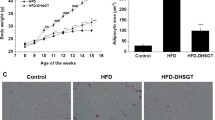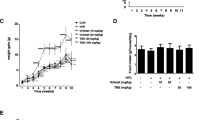Abstract
Purpose
Consumption of dietary supplements with green tea extract (GTE) is popular for weight management, but it may be accompanied by various side effects, including interactions with drugs. The aim of the present in vivo study was to evaluate the effect of defined GTE (Polyphenon 60) in three dosage schemes on insulin, leptin and drug-metabolizing enzymes in obese mice.
Methods
Experimental obesity was induced by repeated s.c. application of monosodium glutamate to newborn mice. Green tea extract was administered in three dosage schemes in chow diet. The plasmatic levels of insulin and leptin were assayed using enzyme-linked immunosorbent assay. Enzyme activities and mRNA expressions of drug-metabolizing enzymes (totally 13) were analyzed in liver and small intestine using spectrophotometric and HPLC assays and RT-PCR, respectively.
Results
GTE-treatment decreased insulin and leptin levels. Eleven enzymes were significantly affected by GTE-treatment. Long-term administration of 0.01 % GTE caused increase in the activity and mRNA level of cytochrome P450 3A4 (CYP3A4) ortholog in the liver as well as in the small intestine. Interestingly, short-term overdose by GTE (0.1 %) had more pronounced effects on enzyme activities and mRNA expressions than long-term overdose.
Conclusions
GTE-mediated induction of CYP3A4 ortholog, the main drug-metabolizing enzyme, could result in decreased efficacy of simultaneously or subsequently administered drug in obese individuals.


Similar content being viewed by others
References
Osei-Hyiaman D, Liu J, Zhou L, Godlewski G, Harvey-White J, Jeong WI, Batkai S, Marsicano G, Lutz B, Buettner C, Kunos G (2008) Hepatic CB(1) receptor is required for development of diet-induced steatosis, dyslipidemia, and insulin and leptin resistance in mice. J Clin Invest 118:3160–3169. doi:10.1172/Jci34827
Picklo M, Claycombe KJ, Meydani M (2012) Adipose dysfunction, interaction of reactive oxygen species, and inflammation. Adv Nutr 3:734–735. doi:10.3945/an.112.002626
Lutz TA, Woods SC (2012) Overview of animal models of obesity. Curr Protoc Pharmacol 58:5.6.1–5.6.18. doi:10.1002/0471141755.ph0561s58
Buettner R, Scholmerich J, Bollheimer LC (2007) High-fat diets: modeling the metabolic disorders of human obesity in rodents. Obesity 15:798–808. doi:10.1038/oby.2007.608
Olney JW (1969) Brain lesions, obesity, and other disturbances in mice treated with monosodium glutamate. Science 164:719–721. doi:10.1126/science.164.3880.719
Matyskova R, Maletinska L, Maixnerova J, Pirnik Z, Kiss A, Zelezna B (2008) Comparison of the obesity phenotypes related to monosodium glutamate effect on arcuate nucleus and/or the high fat diet feeding in C57BL/6 and NMRI mice. Physiol Res 57:727–734
Nagata M, Suzuki W, Iizuka S, Tabuchi M, Maruyama H, Takeda S, Aburada M, Miyamoto K (2006) Type 2 diabetes mellitus in obese mouse model induced by monosodium glutamate. Exp Anim 55:109–115
Sasaki Y, Suzuki W, Shimada T, Iizuka S, Nakamura S, Nagata M, Fujimoto M, Tsuneyama K, Hokao R, Miyamoto K, Aburada M (2009) Dose dependent development of diabetes mellitus and non-alcoholic steatohepatitis in monosodium glutamate-induced obese mice. Life Sci 85:490–498. doi:10.1016/j.lfs.2009.07.017
Fujimoto M, Tsuneyama K, Nakanishi Y, Salunga TL, Nomoto K, Sasaki Y, Iizuka S, Nagata M, Suzuki W, Shimada T, Aburada M, Shimada Y, Gershwin ME, Selmi C (2014) A dietary restriction influences the progression but not the initiation of MSG-Induced nonalcoholic steatohepatitis. J Med Food 17:374–383. doi:10.1089/jmf.2012.0029
Tsuneyama K, Nishida T, Baba H, Taira S, Fujimoto M, Nomoto K, Hayashi S, Miwa S, Nakajima T, Sutoh M, Oda E, Hokao R, Imura J (2014) Neonatal monosodium glutamate treatment causes obesity, diabetes, and macrovesicular steatohepatitis with liver nodules in DIAR mice. J Gastroenterol Hepatol 29:1736–1743. doi:10.1111/jgh.12610
Sasaki Y, Shimada T, Iizuka S, Suzuki W, Makihara H, Teraoka R, Tsuneyama K, Hokao R, Aburada M (2011) Effects of bezafibrate in nonalcoholic steatohepatitis model mice with monosodium glutamate-induced metabolic syndrome. Eur J Pharmacol 662:1–8. doi:10.1016/j.ejphar.2011.04.051
Alarcon-Aguilar FJ, Zamilpa A, Perez-Garcia MD, Almanza-Perez JC, Romero-Nunez E, Campos-Sepulveda EA, Vazquez-Carrillo LI, Roman-Ramos R (2007) Effect of Hibiscus sabdariffa on obesity in MSG mice. J Ethnopharmacol 114:66–71. doi:10.1016/j.jep.2007.07.020
Fujimoto M, Tsuneyama K, Chen SY, Nishida T, Chen JL, Chen YC, Fujimoto T, Imura J, Shimada Y (2012) Study of the effects of monacolin k and other constituents of red yeast rice on obesity, insulin-resistance, hyperlipidemia, and nonalcoholic steatohepatitis using a mouse model of metabolic syndrome. Evid Based Complement Altern Med 2012:892697. doi:10.1155/2012/892697
Fujimoto M, Tsuneyama K, Fujimoto T, Selmi C, Gershwin ME, Shimada Y (2012) Spirulina improves non-alcoholic steatohepatitis, visceral fat macrophage aggregation, and serum leptin in a mouse model of metabolic syndrome. Dig Liver Dis 44:767–774. doi:10.1016/j.dld.2012.02.002
Kumar P, Bhandari U (2013) Protective effect of Trigonella foenum-graecum Linn. on monosodium glutamate-induced dyslipidemia and oxidative stress in rats. Indian J Pharmacol 45:136–140. doi:10.4103/0253-7613.108288
Kaufhold A, Nigam PK, Dhir RN, Shapiro BH (2002) Prevention of latently expressed CYP2C11, CYP3A2, and growth hormone defects in neonatally monosodium glutamate-treated male rats by the N-methyl-D-aspartate receptor antagonist dizocilpine maleate. J Pharmacol Exp Ther 302:490–496. doi:10.1124/jpet.102.034785
Matouskova P, Bartikova H, Bousova I, Levorova L, Szotakova B, Skalova L (2015) Drug-metabolizing and antioxidant enzymes in monosodium l-glutamate obese mice. Drug Metab Dispos 43:258–265. doi:10.1124/dmd.114.061176
Jurgens TM, Whelan AM, Killian L, Doucette S, Kirk S, Foy E (2012) Green tea for weight loss and weight maintenance in overweight or obese adults. Cochrane Database Syst Rev 12:CD008650. doi:10.1002/14651858.CD008650.pub2
Seeram NP, Henning SM, Niu YT, Lee R, Scheuller HS, Heber D (2006) Catechin and caffeine content of green tea dietary supplements and correlation with antioxidant capacity. J Agr Food Chem 54:1599–1603. doi:10.1021/Jf052857r
Khan N, Mukhtar H (2013) Tea and health: studies in humans. Curr Pharm Des 19:6141–6147. doi:10.2174/1381612811319340008
Yang CS, Pan E (2012) The effects of green tea polyphenols on drug metabolism. Expert Opin Drug Metab Toxicol 8:677–689. doi:10.1517/17425255.2012.681375
Matoušková P, Bártiková H, Bousova I, Szotáková B, Martin J, Skorkovská J, Hanušová V, Tománková V, Anzenbacherová E, Lišková B, Anzenbacher P, Skálová L (2014) Effect of defined green tea extract in various dosage schemes on drug-metabolizing enzymes in mice in vivo. J Funct Foods 10:327–335. doi:10.1016/j.jff.2014.06.026
Suter M, Butler JE, Peterman JH (1989) The Immunochemistry of Sandwich Elisas. 3. The stoichiometry and efficacy of the protein-avidin-biotin capture (Pabc) System. Mol Immunol 26:221–230. doi:10.1016/0161-5890(89)90075-8
Gillette J (1971) Techniques for studying drug metabolism in vitro. In: La Du BN, Mandel HG, Way E (eds) Fundamentals of drug metabolism and drug disposition, 1st edn. Williams and Wilkins Company, Baltimore, pp 400–418
Smith PK, Krohn RI, Hermanson GT, Mallia AK, Gartner FH, Provenzano MD, Fujimoto EK, Goeke NM, Olson BJ, Klenk DC (1985) Measurement of protein using bicinchoninic acid. Anal Biochem 150:76–85. doi:10.1016/0003-2697(85)90442-7
Chang TK, Waxman DJ (2006) Catalytic assays for human cytochrome P450: an introduction. Methods Mol Biol 320:73–83. doi:10.1385/1-59259-998-2:73
Maté L, Virkel G, Lifschitz A, Ballent M, Lanusse C (2008) Hepatic and extra-hepatic metabolic pathways involved in flubendazole biotransformation in sheep. Biochem Pharmacol 76:773–783. doi:10.1016/j.bcp.2008.07.002
Palackal NT, Burczynski ME, Harvey RG, Penning TM (2001) The ubiquitous aldehyde reductase (AKR1A1) oxidizes proximate carcinogen trans-dihydrodiols to o-quinones: potential role in polycyclic aromatic hydrocarbon activation. Biochemistry 40:10901–10910. doi:10.1021/bi010872t
Cullen JJ, Hinkhouse MM, Grady M, Gaut AW, Liu J, Zhang YP, Weydert CJ, Domann FE, Oberley LW (2003) Dicumarol inhibition of NADPH:quinone oxidoreductase induces growth inhibition of pancreatic cancer via a superoxide-mediated mechanism. Cancer Res 63:5513–5520
Fitzsimmons SA, Workman P, Grever M, Paull K, Camalier R, Lewis AD (1996) Reductase enzyme expression across the National Cancer Institute Tumor cell line panel: correlation with sensitivity to mitomycin C and EO9. J Natl Cancer Inst 88:259–269. doi:10.1093/jnci/88.5.259
Mizuma T, Machida M, Hayashi M, Awazu S (1982) Correlation of drug conjugative metabolism rates between in vivo and in vitro: glucuronidation and sulfation of p-nitrophenol as a model compound in rat. J Pharmacobiodyn 5:811–817
Habig WH, Jakoby WB (1981) Glutathione S-transferases (rat and human). Methods Enzymol 77:218–231. doi:10.1016/S0076-6879(81)77029-0
Livak KJ, Schmittgen TD (2001) Analysis of relative gene expression data using real-time quantitative PCR and the 2(-Delta Delta C(T)) Method. Methods 25:402–408. doi:10.1006/meth.2001.1262
Matoušková P, Bártíková H, Boušová I, Hanušová V, Szotáková B, Skálová L (2014) Reference genes for real-time PCR quantification of messenger RNAs and microRNAs in mouse model of obesity. PLoS ONE 9:e86033. doi:10.1371/journal.pone.0086033
Roe AL, Howard G, Blouin R, Snawder JE (1999) Characterization of cytochrome P450 and glutathione S-transferase activity and expression in male and female ob/ob mice. Int J Obes Relat Metab Disord 23:48–53
Na HK, Surh YJ (2008) Modulation of Nrf2-mediated antioxidant and detoxifying enzyme induction by the green tea polyphenol EGCG. Food Chem Toxicol 46:1271–1278. doi:10.1016/j.fct.2007.10.006
Boušová I, Hájek J, Dršata J, Skálová L (2012) Naturally occurring flavonoids as inhibitors of purified cytosolic glutathione S-transferase. Xenobiotica 42:872–879. doi:10.3109/00498254.2012.670737
Renouf M, Marmet C, Guy PA, Beaumont M, Lepage M, Williamson G, Dionisi F (2013) Dose-response plasma appearance of green tea catechins in adults. Mol Nutr Food Res 57:833–839. doi:10.1002/mnfr.201200512
Messerer M, Johansson SE, Wolk A (2001) Sociodemographic and health behaviour factors among dietary supplement and natural remedy users. Eur J Clin Nutr 55:1104–1110. doi:10.1038/sj.ejcn.1601272
Dryden GW, Lam A, Beatty K, Qazzaz HH, McClain CJ (2013) A pilot study to evaluate the safety and efficacy of an oral dose of (-)-epigallocatechin-3-gallate-rich polyphenon E in patients with mild to moderate ulcerative colitis. Inflamm Bowel Dis 19:1904–1912. doi:10.1097/MIB.0b013e31828f5198
Spencer JPE, El Mohsen MMA, Rice-Evans C (2004) Cellular uptake and metabolism of flavonoids and their metabolites: implications for their bioactivity. Arch Biochem Biophys 423:148–161. doi:10.1016/j.abb.2003.11.010
Kao YH, Hiipakka RA, Liao SS (2000) Modulation of endocrine systems and food intake by green tea epigallocatechin gallate. Endocrinology 141:980–987. doi:10.1210/En.141.3.980
Weng Z, Greenhaw J, Salminen WF, Shi Q (2012) Mechanisms for epigallocatechin gallate induced inhibition of drug metabolizing enzymes in rat liver microsomes. Toxicol Lett 214:328–338. doi:10.1016/j.toxlet.2012.09.011
Nebert DW, Russell DW (2002) Clinical importance of the cytochromes P450. Lancet 360:1155–1162. doi:10.1016/S0140-6736(02)11203-7
Yamazaki H, Shimada T (1997) Progesterone and testosterone hydroxylation by cytochromes P450 2C19, 2C9, and 3A4 in human liver microsomes. Arch Biochem Biophys 346:161–169. doi:10.1006/abbi.1997.0302
Cuendet M, Oteham CP, Moon RC, Pezzuto JM (2006) Quinone reductase induction as a biomarker for cancer chemoprevention. J Nat Prod 69:460–463. doi:10.1021/np050362q
Bartel DP (2009) MicroRNAs: target recognition and regulatory functions. Cell 136:215–233. doi:10.1016/j.cell.2009.01.002
Milenkovic D, Deval C, Gouranton E, Landrier JF, Scalbert A, Morand C, Mazur A (2012) Modulation of miRNA expression by dietary polyphenols in apoe deficient mice: a new mechanism of the action of polyphenols. PLoS ONE 7:156–167. doi:10.1371/journal.pone.0029837
Acknowledgments
This work was supported by the Czech Science Foundation (Center of Excellence, grant number P303/12/G163) and by the European Social Fund and the state budget of the Czech Republic (Projects no. CZ.1.07/2.3.00/30.0022 and CZ.1.07/2.3.00/30.0004).
Conflict of interest
The authors declare that they have no conflict of interest.
Author information
Authors and Affiliations
Corresponding author
Rights and permissions
About this article
Cite this article
Boušová, I., Matoušková, P., Bártíková, H. et al. Influence of diet supplementation with green tea extract on drug-metabolizing enzymes in a mouse model of monosodium glutamate-induced obesity. Eur J Nutr 55, 361–371 (2016). https://doi.org/10.1007/s00394-015-0856-7
Received:
Accepted:
Published:
Issue Date:
DOI: https://doi.org/10.1007/s00394-015-0856-7




